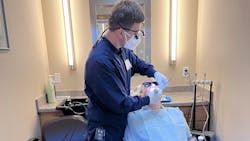Why dental professionals should incorporate portable dentistry
What you'll learn in this article
- A single phone call revealed a hidden dental care crisis for this dental hygienist.
- Mobile dentistry is critical for seniors and special needs patients.
- Barriers can prevent urgent dental treatment in care facilities.
- There are practical steps you can take to expand portable dental services in your community.
- Advocacy and persistence can secure treatment when options seem impossible.
In the summer of 2020, I received a phone call from the wife of a memory care resident in a retirement community where I provide dental hygiene services in Washington state. He was not my patient, but the people there suggested his wife give me a call since I might be able to direct her to resources.
Her husband had a toothache that had persisted for weeks during the COVID pandemic, and he urgently needed a dentist. His wife told me that transporting him wasn’t an option because he simply wouldn’t cooperate.
I told her what I had to tell most people in that area; that I only knew of one mobile dentist provider, and that they may only offer their services within a three-mile radius of their clinic. Her husband was less than three miles away, but she had already tried them, and they told her they weren’t currently doing any “field operations” due to staff shortages during the pandemic.
This was during the time that dental offices were reopening, but many retirement homes and care facilities were still in lockdown. This meant they received no “nonessential” services, including dental hygiene. But this man’s case was an emergency.
His wife told me that she had spent hours searching the web, calling dental offices, and consulting with her own dentist, and she was getting nowhere. I told her I would do some research too and see what I could find. Clearly there’s a serious shortage of mobile dentists in that county, which is part of a metro area. It’s a silent emergency because the public is not aware of the great need.
This couple was not “strapped for cash,” which was a lesson for me that dental pain doesn’t discriminate based on socioeconomic status. It was mindboggling to me that in our country, someone with money, a vocal advocate, in an urban area with plenty of dentists, was living in severe dental pain with no option for care.
What about the countless others in the same predicament who don’t have the financial resources, a care advocate, who live in remote areas or shortage areas? Who will stand up for them?
Hygienist searches for solution for elderly patient
I got to work to fight this problem that just wasn’t right. Some of the most meaningful volunteer work is being a dental care navigator, an advocate. I scoured the web for mobile dentists, emailed a contact at a nonprofit where I volunteered, as well as the city’s dental hygiene program director. I received a couple leads and called some offices, but they wouldn’t visit him; they could only see him in their office.
Because he was over 80 years old, providing a sedative premedication to get him to the office would be risky, as would using other forms of sedation in the office. They recommended checking with the nearest dental school and considering general anesthesia in a hospital setting.
I called and texted the state dental association leadership and received no response. I tried to find contact info for the county dental society, and I had no progress. I told the man’s wife that certainly members of the society would be the most noble of dentists who would be willing to see her husband in the facility. I had faith.
I was willing to bring my mobile equipment and set it up for whichever dentist might come out to perform services. I told her that dentists don’t need a special permit to provide services at a care facility, and if she could find a dentist, I’d be happy to supply the equipment and assist.
Finally, her own dentist agreed to do an exam on-site. They were able to provide treatment in that dentist’s office (they got him there after all) after doing an initial clinical exam at the facility. The kindness of her dentist was heartwarming, and I’m glad this story has a happy ending.
My journey to portable dentistry
Not too long after this incident, I found a rare dentist that became my mobile dentist collaborator.
But the whole incident left me feeling that we must have a stronger safety net in place for situations like this. We’re all getting older, and someday you and I may need the services of portable hygienists and dentists. If we don't stand up for our most vulnerable populations today, who will stand up for us when we become the most vulnerable?
In today’s world, someone can have home health or a hospice nurse visit. Some nurses can prescribe medications to treat infections, including dental infections. Massage therapists can come straight to someone’s home. So can dental hygienists in Oregon and Washington, and dentists can pretty much anywhere without any restrictions. But they are oh-so-hard to come by.
The turf battles over scope of practice between dentists and hygienists have not done any favors for expanding access to much needed home dental services. We must encourage both dentists and hygienists to expand into portable delivery service models by creating favorable policies and conditions and voicing that there is a desperate need for these services for special needs and aging populations.
Dentists should seize the opportunity to send their own staff—associates, dental hygienists, and dental assistants—into care facilities as an extension of their brick-and-mortar practices, even if only in their immediate vicinity. I feel like it’s a moral obligation that we must care for senior and special needs communities.
Dental offices already have most of the infrastructure (staff, sterilizers, instruments, loupes with lights, disposable supplies) to carry out such operations in the community. They may just need to add a portable delivery unit to run handpieces and ultrasonic scalers.
With teledentistry, many screening procedures can be conducted by hygienists and assistants working under the supervision of their dentist. Many states allow direct access for dental hygienists. But even the states that don’t allow direct access still allow hygienists to serve under supervision like that at a dentist-owned practice.
Expanding into the community by offering portable dentistry is not just a charity venture. It can boost business, promote PR for the office, and change lives! Plus, it brings so much joy to the entire staff and is an excellent teambuilding activity.
About the Author

Ilya Babiy, MS, RDH, EPP
Ilya Babiy, MS, RDH, EPP, has been a dental hygienist for more than 18 years and faculty at Mt. Hood Community College for more than 10 years. He started his portable hygiene business, On-Site Oral Health Care, in 2014, and cofounded Good News Dental, an expanded practice dental hygienist brick-and-mortar cooperative clinic, in 2021. He can be reached at [email protected] or on Instagram at @ilya.rdh.
